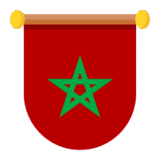The stunning contrast of Marrakech’s terracotta cityscape against the majestic Atlas Mountains
Best Time to Visit Morocco
Timing your Morocco vacation right can make all the difference in your experience. The country experiences distinct seasonal changes that affect both comfort and crowd levels at popular destinations.
Spring (March to May)
Spring offers ideal weather conditions throughout Morocco. Temperatures range from 65°F to 80°F (18°C to 27°C), perfect for exploring cities and hiking in the Atlas Mountains. The countryside bursts with wildflowers, and you’ll avoid the summer tourist crowds. However, be aware that Ramadan may fall during this period, which can affect restaurant opening hours and local services.
Fall (September to November)
Like spring, fall provides comfortable temperatures and fewer tourists. The scorching summer heat subsides, making it pleasant to explore medinas and desert regions. This is an excellent time for photography as the light is particularly beautiful. The Atlas Mountains take on golden hues, creating stunning backdrops for your Morocco vacation photos.
Summer (June to August)
Summer brings intense heat, especially in inland cities like Marrakech and Fez, where temperatures regularly exceed 100°F (38°C). Coastal areas like Essaouira offer relief with cooler breezes. If you must travel during summer, plan outdoor activities for early morning or evening and budget for accommodations with air conditioning.
Winter (December to February)
Winter brings mild temperatures to coastal areas and cities, ranging from 50°F to 65°F (10°C to 18°C). However, nights can be quite cold, especially in the desert and mountains. The Atlas Mountains often receive snow, making this a unique time to witness Morocco’s diverse landscapes. Winter also offers the lowest tourist numbers and best hotel rates.
Ready to experience Morocco in its prime season?
Our seasonal travel packages are designed to showcase Morocco at its best, with itineraries optimized for weather conditions and special cultural events.
Must-Visit Destinations for Your Morocco Vacation
Morocco offers an incredible diversity of experiences across its cities, mountains, deserts, and coastlines. Here are the essential destinations to include in your Morocco vacation itinerary:
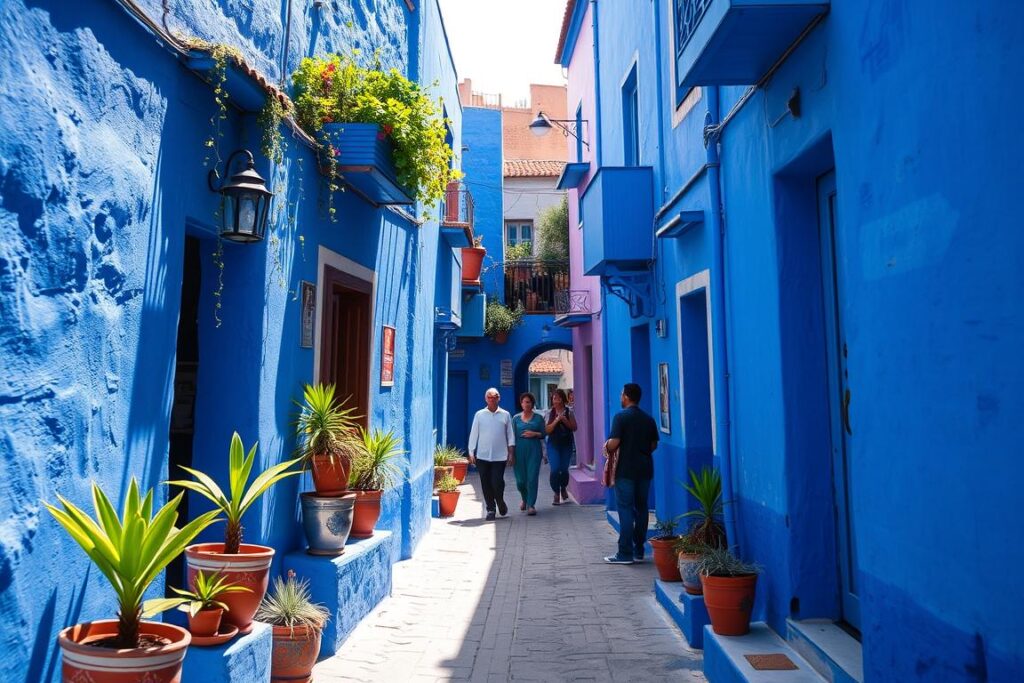
Chefchaouen’s enchanting blue-washed streets create a photographer’s paradise
Marrakech: The Red City
Marrakech embodies the exotic essence of Morocco with its bustling Jemaa el-Fnaa square, labyrinthine medina, and opulent palaces. Don’t miss the Majorelle Garden, once owned by Yves Saint Laurent, with its striking cobalt blue accents and exotic plant collection. The Bahia Palace showcases the height of Moroccan craftsmanship with its intricate tilework and carved cedar ceilings. Plan at least three days here to fully absorb the city’s energy and beauty.
Fez: The Cultural Capital
Fez boasts the world’s largest car-free urban area in its ancient medina, a UNESCO World Heritage site. The city’s medieval architecture remains remarkably preserved, with highlights including the Al-Qarawiyyin University (the world’s oldest), the stunning Bou Inania Madrasa, and the famous leather tanneries. The sensory experience of Fez—from the calls to prayer echoing across the city to the aromatic spice markets—is unmatched.
Chefchaouen: The Blue Pearl
Nestled in the Rif Mountains, Chefchaouen enchants visitors with its blue-washed buildings creating a dreamlike atmosphere. The relaxed pace here offers a welcome contrast to Morocco’s imperial cities. Wander the blue alleyways, shop for handcrafted goods, and hike to the Spanish Mosque for panoramic sunset views. This photogenic town has become increasingly popular, so consider visiting during weekdays to avoid crowds.
Sahara Desert
No Morocco vacation is complete without experiencing the majestic Sahara Desert. The most accessible dunes are at Erg Chebbi near Merzouga and Erg Chigaga near M’hamid. A typical desert experience includes a camel trek to a Berber camp, traditional dinner under the stars, and sunrise over the dunes. The journey to reach the desert is long but rewarding, with spectacular scenery along the way.
Essaouira: The Windy City
This laid-back coastal town offers a refreshing change from inland Morocco. Essaouira’s whitewashed buildings with blue accents, protected harbor, and expansive beaches create a relaxed atmosphere. The medina is less overwhelming than those in larger cities, making it perfect for stress-free exploration. Seafood restaurants line the harbor, serving the day’s fresh catch, while the constant breeze attracts windsurfers and kitesurfers.
Atlas Mountains
The Atlas range provides a stunning natural backdrop to your Morocco vacation. Visit Berber villages where traditional ways of life continue, hike to North Africa’s highest peak (Mount Toubkal), or simply enjoy the dramatic scenery on a day trip from Marrakech. The Ourika Valley offers an accessible taste of mountain life, while more remote areas like the Dades Valley and Todra Gorge showcase spectacular rock formations.
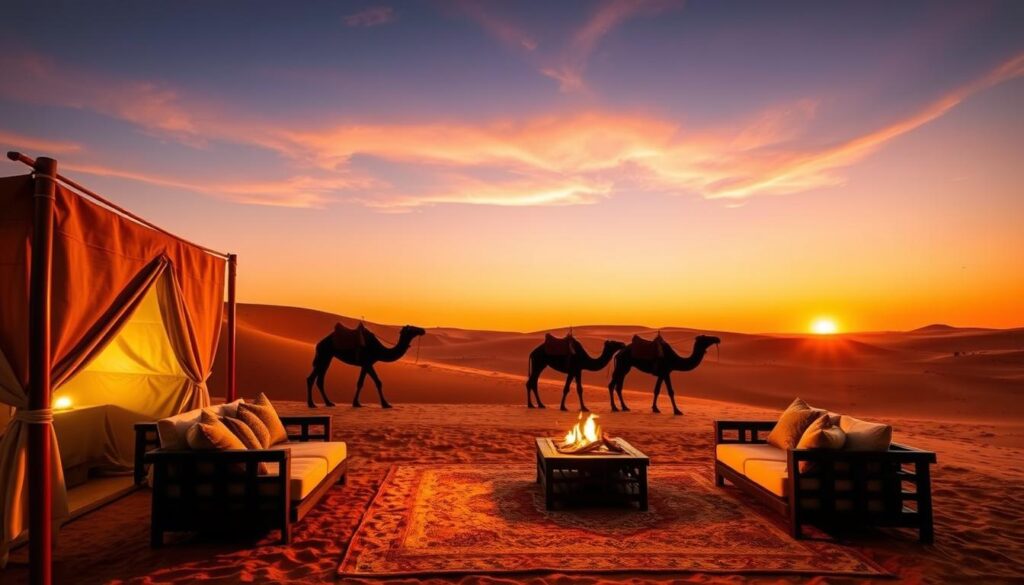
Experience the magic of a night under the stars in a luxury desert camp during your Morocco vacation
Immersive Cultural Experiences
Morocco’s rich cultural tapestry offers travelers countless opportunities for authentic experiences that go beyond typical sightseeing. Here are some cultural highlights to incorporate into your Morocco vacation:
Exploring the Medinas
Morocco’s ancient walled cities are living museums where centuries-old traditions continue. Each medina has its own character: Fez feels like stepping back in time, Marrakech pulses with energy, and Essaouira offers a more relaxed atmosphere. Hire a local guide for your first visit to help navigate the labyrinthine streets and avoid getting lost. Learn the art of haggling in the souks, where everything from spices and ceramics to textiles and metalwork is available.
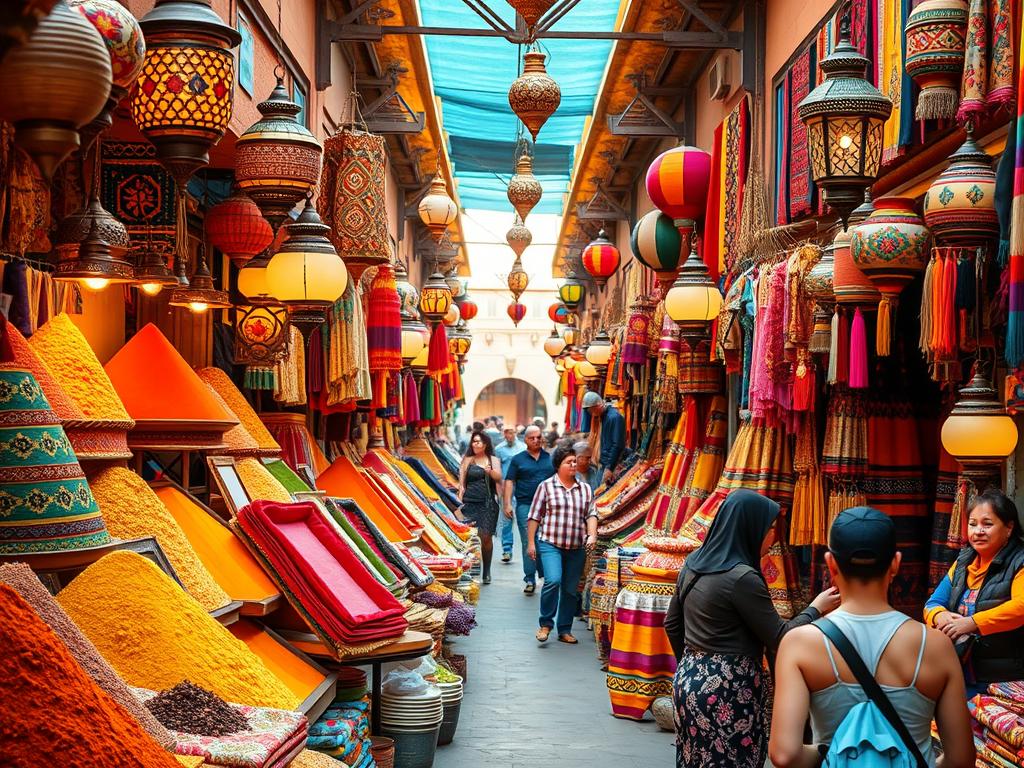
The vibrant colors and exotic scents of Moroccan souks create an unforgettable sensory experience
Traditional Hammam Experience
The hammam (public bath) remains an integral part of Moroccan life. This purification ritual involves steam rooms of varying temperatures, followed by a vigorous scrubbing with black soap made from olive oil. Many riads and hotels offer private hammam experiences, but visiting a local hammam provides a more authentic glimpse into Moroccan culture. The experience leaves you feeling thoroughly cleansed and refreshed.
Moroccan Cuisine and Cooking Classes
Moroccan food blends Berber, Arabic, and Mediterranean influences into distinctive flavors. Beyond the famous tagine (slow-cooked stew) and couscous, try pastilla (savory-sweet meat pie), harira (hearty soup), and an array of fresh salads. Participating in a cooking class allows you to bring these flavors home. Many classes begin with a market visit to select ingredients before learning traditional cooking techniques from local chefs.
Mint Tea Ceremony
The preparation and serving of mint tea is an art form and symbol of Moroccan hospitality. The tea is traditionally poured from height to create a frothy top, and is usually very sweet. Accepting tea when offered is considered polite, as is consuming at least two glasses. Many riads offer demonstrations of the proper preparation technique, which involves fresh mint leaves, green tea, and sugar blocks.
Traditional Music and Dance
Gnawa music, with its hypnotic rhythms and spiritual roots, can be experienced in many coastal towns, particularly Essaouira. In the Atlas Mountains, Berber communities preserve their musical traditions with communal performances. Many restaurants in tourist areas offer dinner shows featuring traditional music and belly dancing, though for more authentic experiences, ask locals about community celebrations or festivals happening during your visit.
Artisan Workshops
Morocco’s craft traditions have been passed down through generations. Visit workshops to see artisans creating intricate zellige tilework, hand-knotted carpets, tooled leather, and carved wood. Fez is particularly known for its craftsmanship, with dedicated areas for different crafts in its medina. Many workshops welcome visitors and offer demonstrations of their techniques, providing deeper appreciation for the handcrafted items you might purchase.
Practical Tips for Your Morocco Vacation
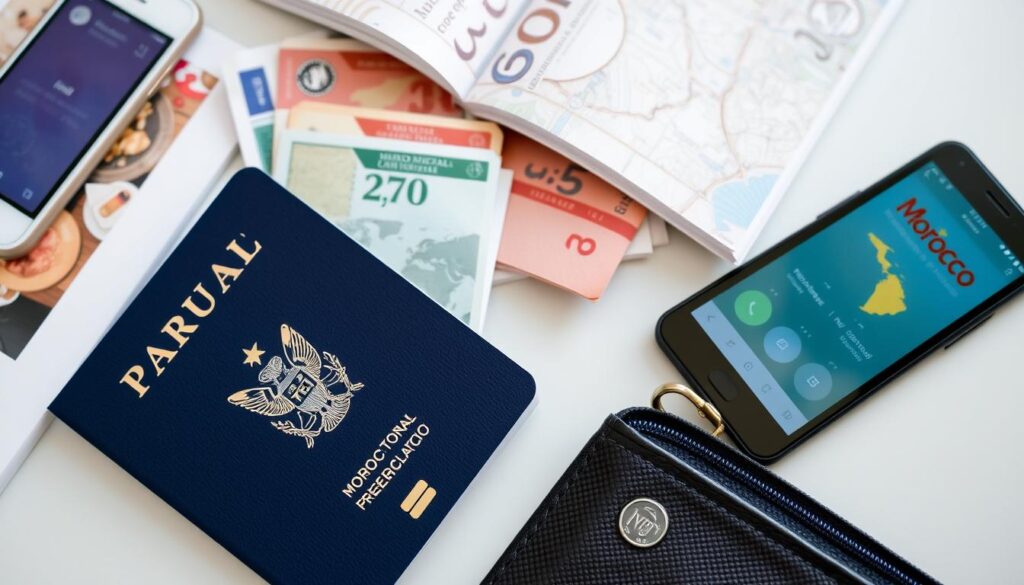
Proper preparation with the right documents and local currency will ensure a smooth Morocco vacation
Visa and Entry Requirements
Travelers from many countries including the US, Canada, EU, UK, Australia, and New Zealand can enter Morocco without a visa for stays up to 90 days. Your passport should be valid for at least six months beyond your entry date. Always check the latest requirements before traveling, as regulations can change. Upon arrival, you’ll need to complete an entry form, which is typically provided on your flight or at the airport.
Currency and Money
The Moroccan currency is the dirham (MAD), which can only be obtained within Morocco. ATMs are widely available in cities and towns, offering better exchange rates than currency exchange offices. Inform your bank of your travel plans to prevent card blocks. While credit cards are accepted at higher-end establishments, cash is essential for markets, taxis, and smaller restaurants. Bargaining is expected in souks, but not in fixed-price shops or restaurants.
Language
Arabic and Berber are Morocco’s official languages, but French is widely spoken in tourist areas. English proficiency varies, with more speakers in major tourist destinations. Learning a few basic Arabic phrases shows respect and often enhances your experience. Common useful phrases include “shukran” (thank you), “la shukran” (no thank you), and “salam alaikum” (peace be upon you, a common greeting).
Dress Code and Cultural Sensitivity
Morocco is a Muslim country with conservative dress standards, especially outside tourist areas. Both men and women should cover shoulders and knees. Women should pack loose-fitting clothes and a scarf for visiting religious sites. Showing respect for local customs enhances your experience and interactions. During Ramadan, avoid eating, drinking, or smoking in public during daylight hours out of respect for those fasting.
Transportation Options
| Transport Type | Best For | Cost | Tips |
| Trains | Travel between major cities | Moderate | First-class tickets recommended for longer journeys; book in advance for popular routes |
| Buses | Reaching smaller towns | Low | CTM and Supratours are reliable companies with comfortable buses |
| Grand Taxis | Intercity travel | Low-Moderate | Shared service; departs when full (6 passengers) |
| Petit Taxis | Getting around within cities | Low | Insist on using the meter; different colors in each city |
| Private Driver | Customized itineraries | High | Most comfortable option; allows stops at points of interest |
| Domestic Flights | Covering long distances quickly | High | Limited routes; mainly useful for reaching southern cities |
Is Morocco safe for tourists?
Morocco is generally safe for tourists, with low rates of violent crime. However, petty theft and scams targeting tourists do occur, particularly in crowded areas. Exercise normal precautions: be aware of your surroundings, avoid displaying valuable items, use hotel safes, and be cautious with your belongings in busy markets. Solo female travelers may experience unwanted attention; dressing conservatively and projecting confidence helps minimize this.
How much should I budget for a Morocco vacation?
Morocco can accommodate various budgets. Budget travelers can manage on $50-70 per day, including modest accommodations, public transportation, and eating at local establishments. Mid-range travelers should budget $100-200 daily for comfortable riads, private transportation between cities, and better restaurants. Luxury experiences with high-end riads, private drivers, and gourmet dining can exceed $300 daily. Additional costs include shopping, guided tours, and desert excursions.
What should I pack for Morocco?
Pack lightweight, modest clothing that covers shoulders and knees. Include a scarf for women (useful for sun protection and visiting religious sites), comfortable walking shoes, sun protection (hat, sunglasses, sunscreen), a light jacket for evenings (especially in desert and mountain regions), basic medications, and wet wipes/hand sanitizer. A small daypack is useful for exploring, and consider bringing a universal power adapter.
Need help planning your Morocco itinerary?
Our travel experts can create a customized Morocco vacation plan based on your interests, timeframe, and budget.
Where to Stay During Your Morocco Vacation
Morocco offers diverse accommodation options to suit every preference and budget. Here’s what you need to know about the main types of lodging:
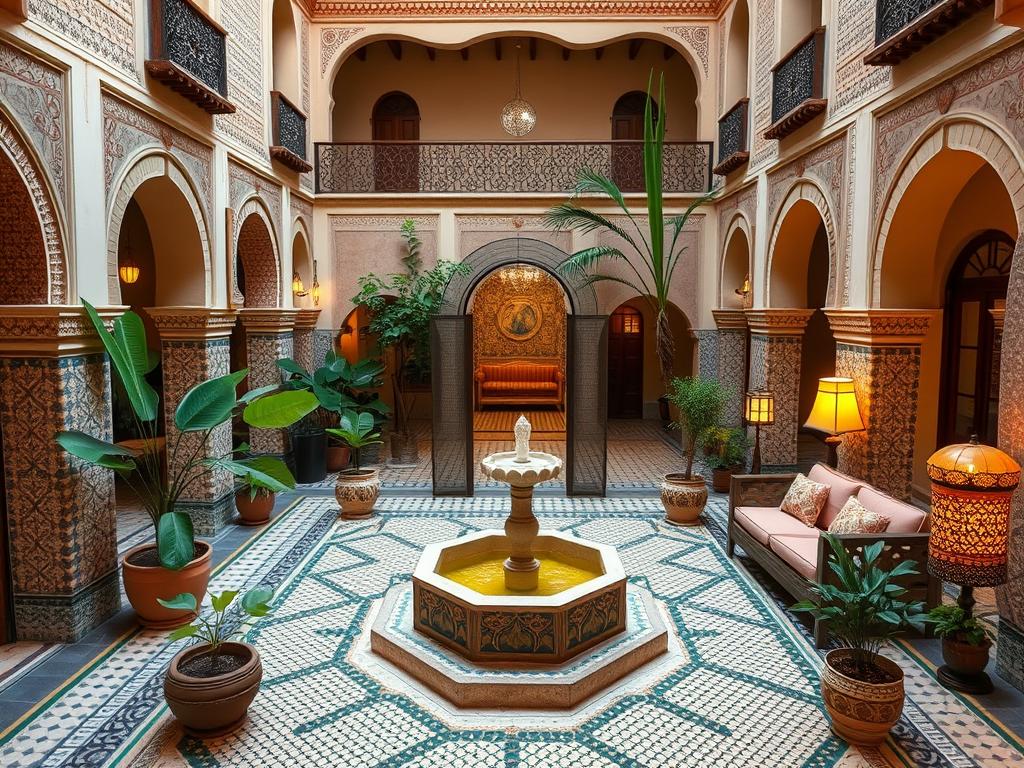
Traditional riads offer an authentic and often luxurious accommodation experience centered around a beautiful courtyard
Riads: Traditional Moroccan Houses
For an authentic Morocco vacation experience, stay in a riad—a traditional house built around a central courtyard, often with a fountain or small pool. These architectural gems have been converted into boutique hotels that range from budget-friendly to ultra-luxurious. The inward-facing design provides a peaceful retreat from bustling medinas. Each riad has its own character, with many featuring stunning traditional craftsmanship including intricate tilework, carved plaster, and painted cedar ceilings.
Hotels and Resorts
International and local hotel chains offer modern amenities and conveniences, particularly in major cities and beach destinations. These range from basic accommodations to five-star luxury properties with spas, pools, and multiple restaurants. Hotels outside the medina typically offer easier access by car and more spacious rooms but may lack the character and central location of riads.
Desert Camps
Spending a night in the Sahara is a highlight of many Morocco vacations. Desert camps range from basic (shared tents, simple mattresses, basic toilet facilities) to luxury (private tents with proper beds, en-suite bathrooms, gourmet dining). The more luxurious camps offer surprising comforts while maintaining the magical experience of sleeping under the desert stars. Most camps include dinner with traditional music, camel rides, and sandboarding activities.
Mountain Lodges and Kasbahs
In the Atlas Mountains, converted kasbahs (fortified houses) and purpose-built lodges offer comfortable bases for hiking and exploring Berber villages. These accommodations often feature stunning mountain views, local architecture, and opportunities to experience rural Moroccan life. Many serve traditional home-cooked meals using local ingredients, providing an authentic taste of regional cuisine.
Booking Tips
- Reserve accommodations well in advance for high season (spring and fall)
- Confirm airport transfers with your riad, as medinas are not accessible by car
- Request rooms away from the street or courtyard if you’re a light sleeper
- Check if your accommodation has air conditioning if visiting in summer
- Ask about heating options for winter stays, especially in desert and mountain regions
Moroccan Cuisine: A Feast for the Senses
Moroccan food is an essential part of your vacation experience, blending Berber, Arab, Mediterranean, and French influences into a distinctive and flavorful cuisine. Here’s what you should know about eating your way through Morocco:
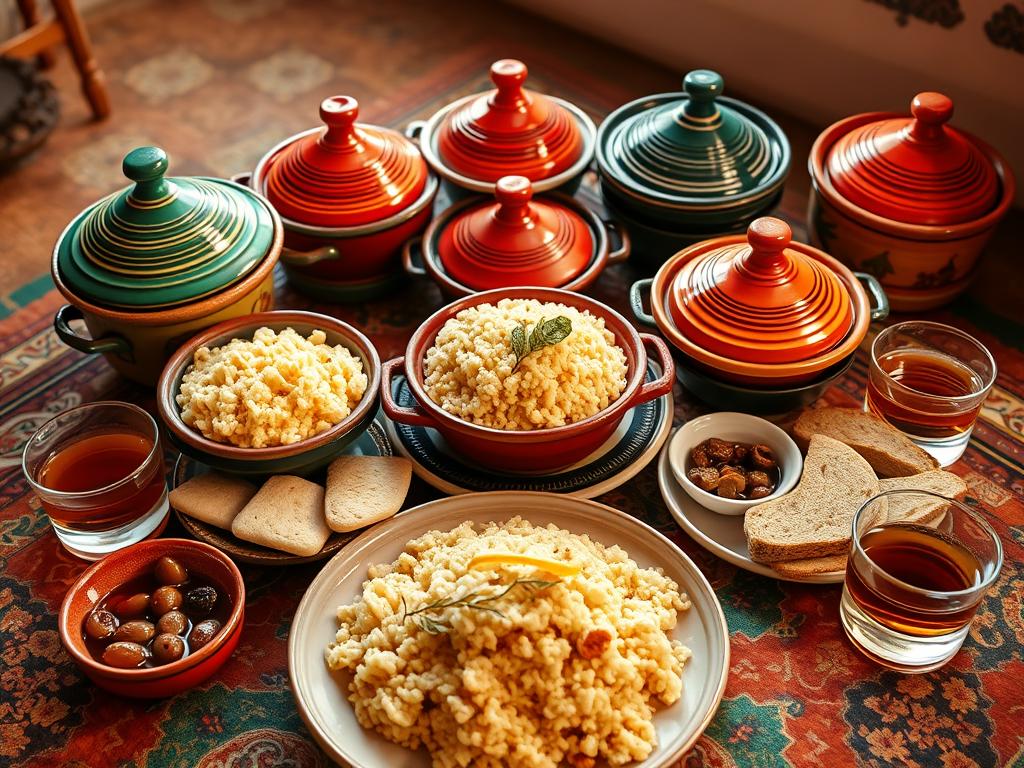
A traditional Moroccan feast featuring tagines, couscous, and mint tea offers a symphony of flavors and aromas
Must-Try Dishes
Tagine
Named after the conical earthenware pot it’s cooked in, tagine is a slow-cooked stew that allows flavors to meld beautifully. Popular variations include chicken with preserved lemon and olives, lamb with prunes and almonds, and kefta (meatball) with eggs. The slow cooking process creates tender meat and vegetables infused with aromatic spices like cumin, cinnamon, and saffron.
Couscous
Traditionally served on Fridays after prayers, couscous is Morocco’s national dish. Tiny semolina granules are steamed over a flavorful broth containing meat and vegetables. The completed dish is topped with the tender meat and vegetables and served with a bowl of the cooking broth on the side. Sweet versions with cinnamon, sugar, and raisins are also popular.
Pastilla
This sweet-savory pie represents Moroccan cuisine’s sophisticated side. Traditionally made with pigeon (though often chicken today), the filling is spiced with cinnamon, saffron, and herbs, wrapped in paper-thin warqa pastry, and topped with powdered sugar and cinnamon. The contrast between the savory filling and sweet exterior creates a memorable flavor experience.
Moroccan Salads
A typical Moroccan meal begins with an array of small salads. These might include zaalouk (smoky eggplant), taktouka (roasted peppers and tomatoes), and various combinations of raw and cooked vegetables seasoned with herbs and spices. These refreshing starters provide a vibrant beginning to heavier main courses.
Dining Experiences
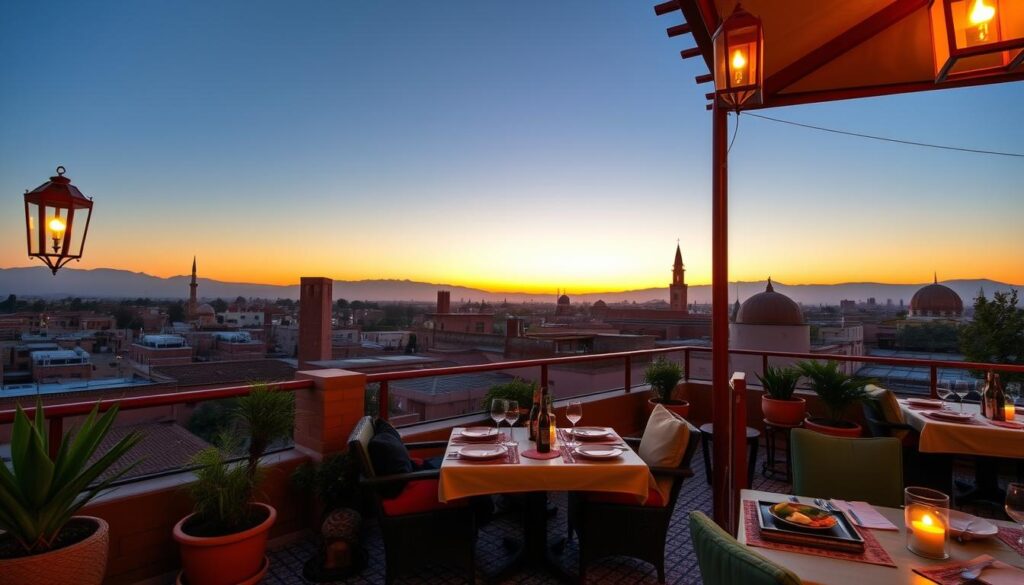
Rooftop dining in Marrakech offers spectacular views and a magical atmosphere as the sun sets
Street Food
Moroccan street food offers delicious, affordable options for sampling local flavors. In Marrakech’s Jemaa el-Fnaa, evening food stalls serve grilled meats, harira soup, and snail broth. Throughout Morocco, look for freshly fried sfenj (doughnuts), msemen (flaky pancakes), and sandwiches filled with grilled meats or seafood. For safety, choose busy stalls where food is cooked to order.
Cooking Classes
Learning to prepare Moroccan dishes provides lasting memories and skills to recreate the flavors at home. Many riads and cooking schools offer half or full-day classes that begin with market visits to select ingredients. You’ll learn techniques for preparing tagines, bread, pastries, and the proper way to brew mint tea. Most classes conclude with enjoying the meal you’ve prepared.
“To understand Moroccan cuisine is to understand Morocco itself—a complex blend of cultures and traditions that come together to create something uniquely delicious and welcoming.”
Dining Tips
- Moroccans traditionally eat with the right hand, using bread to scoop up food
- It’s polite to accept mint tea when offered; it’s a symbol of hospitality
- Restaurants in tourist areas often serve alcohol, but many local establishments do not
- Tipping 10% is customary in restaurants that cater to tourists
- During Ramadan, many restaurants close during daylight hours; plan accordingly
Shopping: Treasures to Bring Home
Shopping in Morocco is an adventure in itself, with treasures waiting to be discovered in the labyrinthine souks. Here’s what to look for and how to navigate the shopping experience:
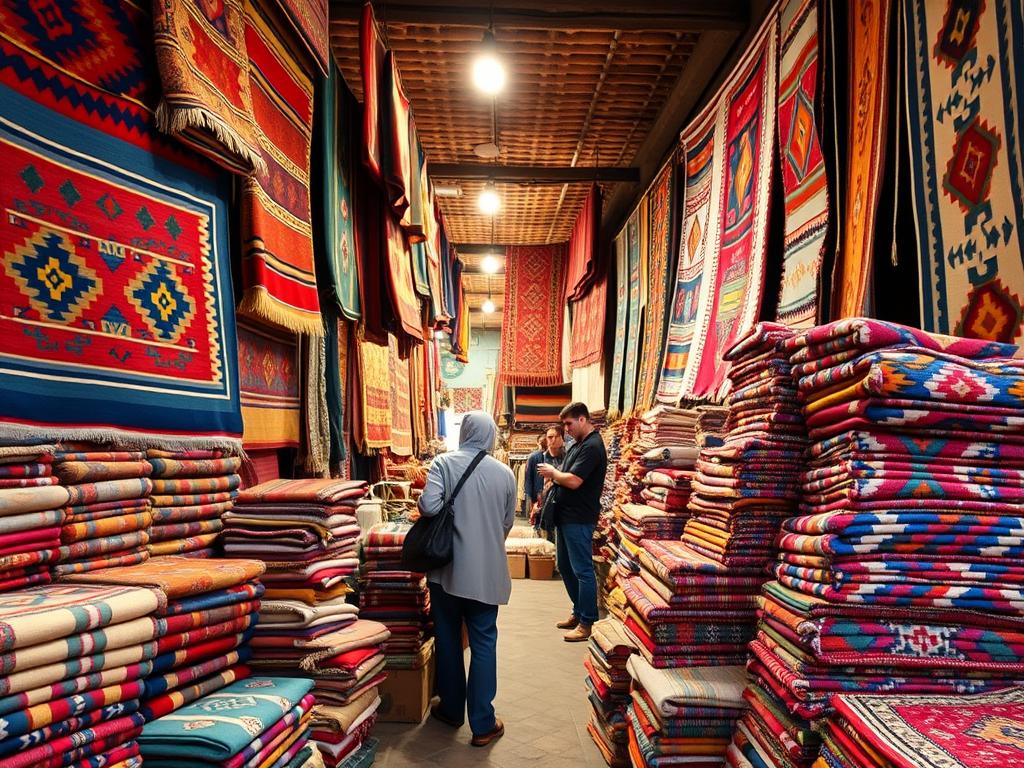
The vibrant colors and intricate patterns of Moroccan carpets make them popular souvenirs
What to Buy
Textiles
Moroccan carpets vary by region, from the geometric patterns of Berber rugs to the colorful designs of urban workshops. Other textile treasures include embroidered table linens, handwoven blankets, and silk or cotton scarves. Quality pieces represent significant investments but can last generations. For carpets, understand the difference between machine-made and handwoven pieces before purchasing.
Ceramics & Metalwork
Fez is famous for its blue pottery, featuring intricate hand-painted designs. Look for plates, bowls, and decorative items. Moroccan metalwork includes ornate lamps, teapots, and trays in brass, copper, or silver. These items combine functionality with beautiful craftsmanship. For ceramics, check for chips or cracks; for metalwork, examine the quality of engravings and joints.
Leather & Argan Products
Moroccan leather goods—from poufs and bags to slippers and belts—are renowned for their quality. The tanneries of Fez offer the most authentic selection. Argan oil products, including culinary oils and cosmetics, make practical souvenirs with health benefits. For leather, smell the product (good leather has a distinctive scent); for argan products, check for proper certification.
The Art of Haggling
Negotiating prices is an expected part of shopping in Morocco’s souks. Begin by establishing rapport with the vendor through friendly conversation. When you express interest in an item, the seller will quote an initial price that’s typically two to five times the actual value. Counter with about 40% of the asking price and work toward a middle ground. Be prepared to walk away if you can’t reach a satisfactory price—this often results in the vendor calling you back with a better offer.
Shopping Tips
- Shop around before buying to understand fair price ranges for items
- Bring cash, as credit cards aren’t accepted in most souks
- Factor in shipping costs for larger items like carpets and furniture
- Keep purchases under $800 per person to avoid customs duties when returning to the US
- Get receipts for valuable items to facilitate customs declarations
Ethical Shopping
Support women’s cooperatives and fair-trade organizations that ensure artisans receive fair compensation for their work. These establishments typically have fixed prices but offer the assurance that your purchase directly benefits the creators. Notable examples include the women’s argan cooperatives near Essaouira and carpet weaving collectives in the Middle Atlas. Many offer demonstrations of traditional techniques, providing educational value alongside shopping opportunities.
Sample Morocco Vacation Itineraries
Planning the perfect Morocco itinerary depends on your interests and available time. Here are some suggested routes to inspire your planning:
A well-planned Morocco vacation itinerary allows you to experience the country’s diverse landscapes and cultures
Classic Morocco: 10 Days
- Days 1-3: Marrakech – Explore the medina, Majorelle Garden, and Bahia Palace. Take a day trip to the Atlas Mountains.
- Days 4-5: Sahara Desert – Travel through the High Atlas Mountains, visit Ait Ben Haddou, and spend a night in a desert camp near Merzouga.
- Days 6-7: Fez – Explore the ancient medina, visit the tanneries, and take a day trip to the Roman ruins at Volubilis.
- Days 8-9: Chefchaouen – Wander the blue streets and hike in the surrounding Rif Mountains.
- Day 10: Casablanca – Visit the Hassan II Mosque before departure.
Morocco Highlights: 7 Days
- Days 1-2: Marrakech – Essential sights and shopping
- Days 3-4: Sahara Experience – Desert excursion with overnight camp
- Days 5-6: Fez – Historic medina exploration
- Day 7: Casablanca – Departure day
This condensed itinerary covers Morocco’s most iconic experiences but involves significant travel time between destinations. Consider a domestic flight from Fez to Casablanca to save time.
Coastal & Cultural: 14 Days
- Days 1-3: Casablanca & Rabat – Modern Morocco
- Days 4-5: Chefchaouen – Blue city relaxation
- Days 6-8: Fez – Cultural immersion
- Days 9-10: Marrakech – Imperial city exploration
- Days 11-13: Essaouira – Coastal charm
- Day 14: Marrakech – Departure
This leisurely itinerary balances urban exploration with relaxing coastal time, ideal for travelers who prefer a slower pace with less driving.
Customizing Your Itinerary
Consider these factors when planning your route:
- Travel pace: Morocco rewards slow travel. Build in rest days and allow time for unexpected discoveries.
- Distances: Travel between major destinations often takes longer than expected due to mountain roads and frequent stops.
- Interests: Tailor your itinerary to your passions—whether architecture, photography, hiking, or culinary experiences.
- Seasons: Adjust your route based on when you’re visiting. Summer travelers should prioritize coastal areas and mountains over inland cities.
Ready to make your Morocco dreams a reality?
Our travel specialists can help you create the perfect Morocco vacation itinerary based on your interests, timeframe, and budget.
Embrace the Magic of Morocco
A Morocco vacation offers an intoxicating blend of sensory experiences, cultural discoveries, and breathtaking landscapes. From the moment you step into your first medina and hear the call to prayer echoing across terracotta rooftops, you’ll understand why this North African gem captivates travelers from around the world.
Whether you’re haggling for treasures in ancient souks, sipping mint tea with Berber villagers in the Atlas Mountains, or watching the sun set over Sahara dunes, Morocco rewards those who approach it with an open heart and curious mind. The country’s rich tapestry of traditions, flavors, and landscapes creates memories that linger long after you’ve returned home.
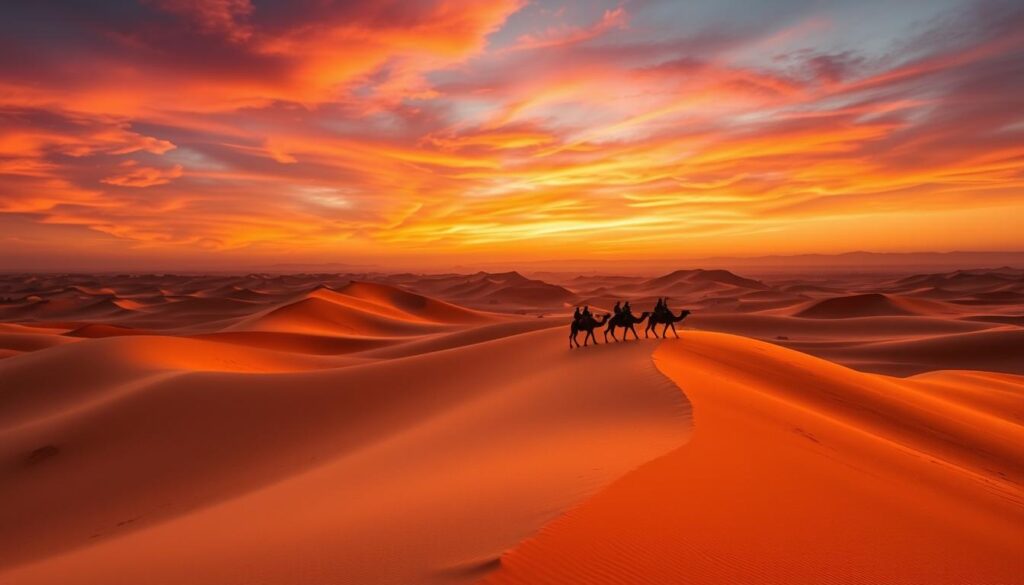
The magical experience of watching the sun set over the Sahara dunes epitomizes the wonder of a Morocco vacation
As you plan your journey, remember that Morocco’s greatest treasures often lie in unexpected moments—a spontaneous invitation to share a meal with locals, a wrong turn that leads to a hidden architectural gem, or a conversation with an artisan about techniques passed down through generations. Allow room in your itinerary for these serendipitous discoveries that transform a good vacation into an unforgettable one.
Begin Your Moroccan Adventure
Let us help you create the Morocco vacation of your dreams with personalized itineraries, expert guides, and unforgettable experiences.
